US gasoline prices have shot through the sensitive barrier of $5 per gallon, even as the country is reeling from high levels of inflation. It's the first time in history that the national average gasoline price has crossed the $5 mark.
According to AAA, the national average price for unleaded gasoline was $5.004 a gallon on Saturday, June 11.
Headwinds for Biden Administration
Elevated levels of gasoline prices are a headache to the Joe Biden administration, which is grappling to rein in inflation. It is also going to be a key campaign plank for the upcoming mitd-term elections, which are predicted to be a setback for Biden's Democrats.

However, oil companies have recorded strong profits as gas prices have remained high. Oil giant Shell reported record quarterly profits in May, while Chevron Corp and BP have also reported their best performance in about ten years.
Oil Companies Offering Share Repurchase
Other oil companies that reported strong results include Exxon Mobil and TotalEnergies. Several oil companies have seen their stock rising, so much so they are offering share repurchases and dividend investments.

At the same time, analysts have warned that excessively high levels of gasoline prices will cause demand destruction. Companies are anticipating this, and are, hence, holding off on making large investments into capacity building for the future.
"The $5 level is where we could see very heavy amounts of gasoline demand destruction," Reid L'Anson, senior economist at Kpler, told Reuters.

Uncertainty over the direction of the Ukraine war is one of the reasons for the high gasoline prices, but that is not the only factor. A robust demand rebound across the world following a two-year lull caused by the coronavirus pandemic is a major factor that is pushing gas prices. The western sanctions on Russia and the move to enforce embargo on Russian crude, along with the OPEC bloc's refusal to pump more crude are also factors behind the surge in prices.
Demand Destruction Will Set in
Economists believe that crude prices will eventually start falling if US gasoline prices remain above $5 for a longer period. That is because the scenario known as demand destruction will set in, effectively killing the demand for the commodity whose prices have remained elevated.

"Demand destruction occurs when a period of high prices or restricted supply causes consumers to permanently change their behavior. This results in a reduction of demand for a good even after the supply of the good goes up and/or its price goes down. This phenomenon is most often associated with the demand and prices related to energy commodities such as crude oil or gasoline," says Investopedia.
Though demand destruction in commodities is an abrupt or sentimental reaction to persistently high price scenario, the result can linger far longer afterward. This has been accurately observed in commodities like fuel, wherein consumers tend to switch to more economically viable option over the long term.








